key battery ASTON MARTIN V8 VANTAGE 2010 User Guide
[x] Cancel search | Manufacturer: ASTON MARTIN, Model Year: 2010, Model line: V8 VANTAGE, Model: ASTON MARTIN V8 VANTAGE 2010Pages: 947, PDF Size: 43.21 MB
Page 654 of 947
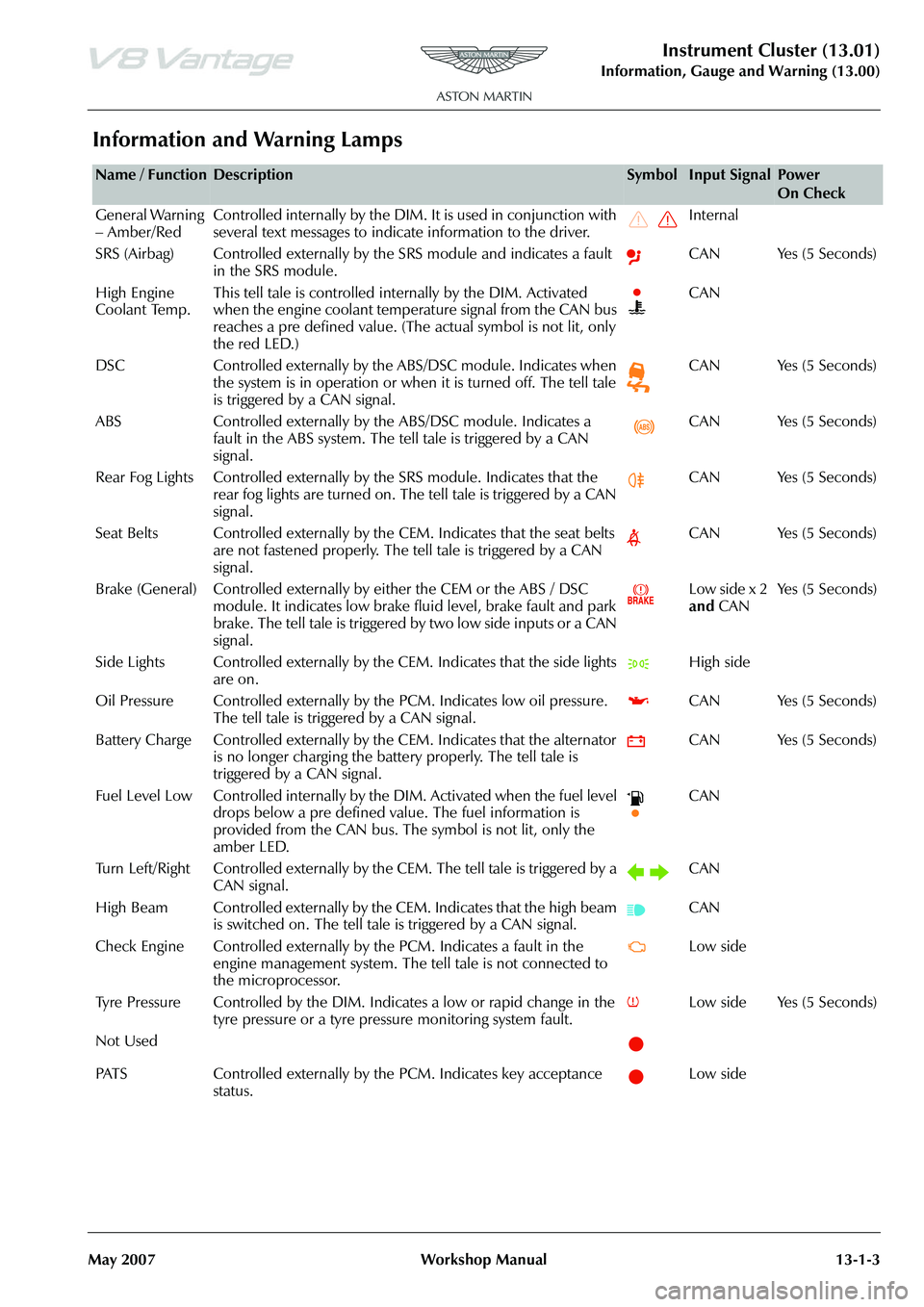
Instrument Cluster (13.01)
Information, Gauge and Warning (13.00)
May 2007 Workshop Manual 13-1-3
Information and Warning Lamps
Name / FunctionDescriptionSymbolInput SignalPower
On Check
General Warning
– Amber/Red Controlled internally by the DIM. It is used in conjunction with
several text messages to indicate information to the driver. Internal
SRS (Airbag) Controlled externally by the SRS module and indicates a fault in the SRS module. CAN Yes (5 Seconds)
High Engine
Coolant Temp. This tell tale is controlled internally by the DIM. Activated
when the engine coolant temperature signal from the CAN bus
reaches a pre defined value. (The
actual symbol is not lit, only
the red LED.) CAN
DSC Controlled externally by the ABS/DSC module. Indicates when the system is in operation or when it is turned off. The tell tale
is triggered by a CAN signal. CAN Yes (5 Seconds)
ABS Controlled externally by th e ABS/DSC module. Indicates a
fault in the ABS system. The tell tale is triggered by a CAN
signal. CAN Yes (5 Seconds)
Rear Fog Lights Controlled externally by the SRS module. Indicates that the
rear fog lights are turned on. The tell tale is triggered by a CAN
signal. CAN Yes (5 Seconds)
Seat Belts Controlled externally by the CEM. Indicates that the seat belts are not fastened properly. The tell tale is triggered by a CAN
signal. CAN Yes (5 Seconds)
Brake (General) Controlled externally by either the CEM or the ABS / DSC module. It indicates low brake fluid level, brake fault and park
brake. The tell tale is triggered by two low side inputs or a CAN
signal. Low side x 2
and
CAN Ye s ( 5 S e c o n d s )
Side Lights Controlled externally by th e CEM. Indicates that the side lights
are on. High side
Oil Pressure Controlled exte rnally by the PCM. Indicates low oil pressure.
The tell tale is triggered by a CAN signal. CAN Yes (5 Seconds)
Battery Charge Controlled externally by th e CEM. Indicates that the alternator
is no longer charging the battery properly. The tell tale is
triggered by a CAN signal. CAN Yes (5 Seconds)
Fuel Level Low Controlled internally by the DIM. Activated when the fuel level drops below a pre defined value. The fuel information is
provided from the CAN bus. The symbol is not lit, only the
amber LED. CAN
Turn Left/Right Controlled externally by th e CEM. The tell tale is triggered by a
CAN signal. CAN
High Beam Controlled externally by the CEM. Indicates that the high beam is switched on. The tell tale is triggered by a CAN signal. CAN
Check Engine Controlled externally by the PCM. Indicates a fault in the engine management system. The te ll tale is not connected to
the microprocessor. Low side
Tyre Pressure Controlled by the DIM. In dicates a low or rapid change in the
tyre pressure or a tyre pressure monitoring system fault. Low side Yes (5 Seconds)
Not Used
PATS Controlled externally by the PCM. Indicates key acceptance status. Low side
Page 692 of 947
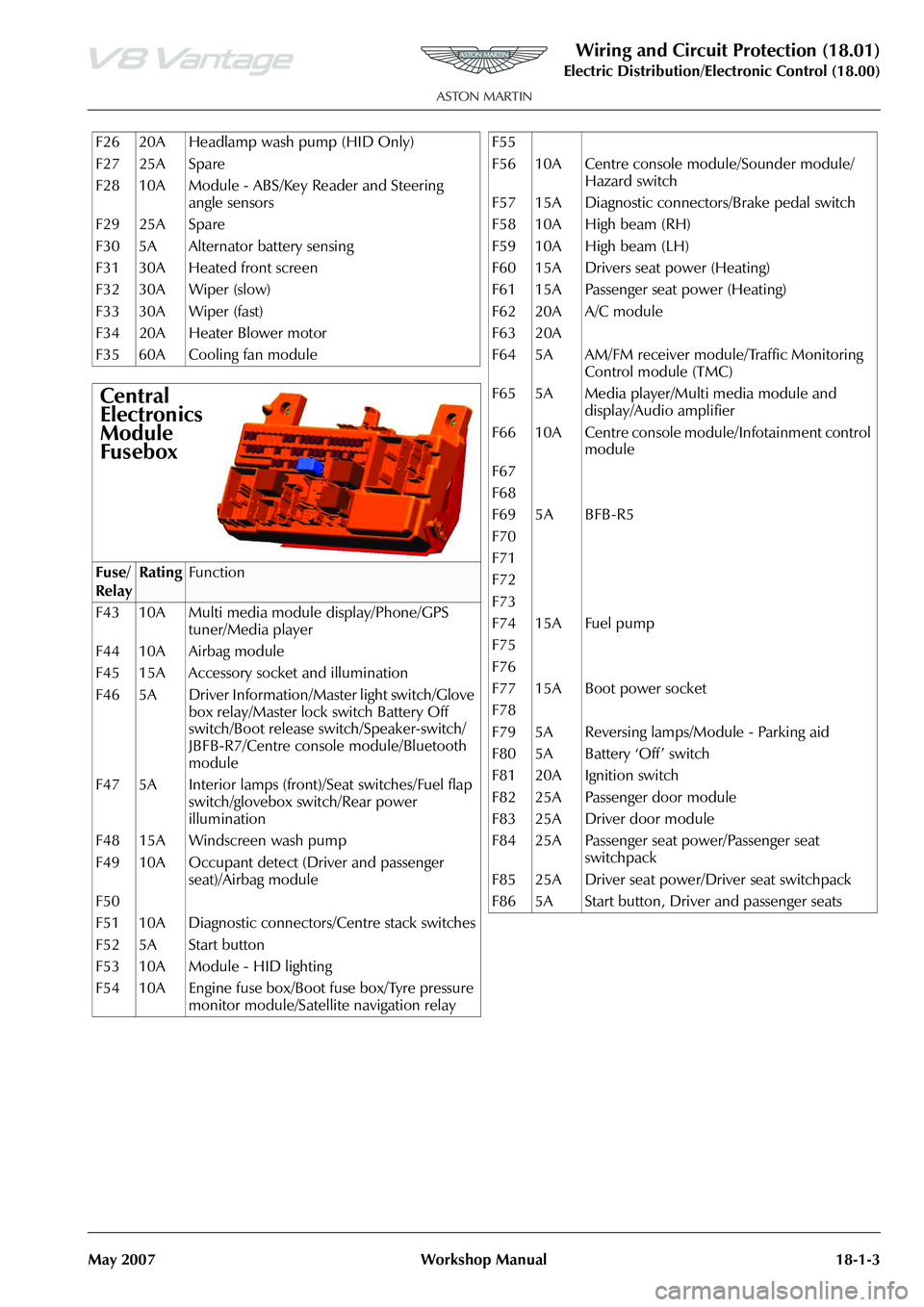
Wiring and Circuit Protection (18.01)
Electric Distribution/Electronic Control (18.00)
May 2007 Workshop Manual 18-1-3
F26 20A Headlamp wash pump (HID Only)
F27 25A Spare
F28 10A Module - ABS/Key Reader and Steering angle sensors
F29 25A Spare
F30 5A Alternator battery sensing
F31 30A Heated front screen
F32 30A Wiper (slow)
F33 30A Wiper (fast)
F34 20A Heater Blower motor
F35 60A Cooling fan module
Central
Electronics
Module
Fusebox
Fuse/
RelayRatingFunction
F43 10A Multi media module display/Phone/GPS tuner/Media player
F44 10A Airbag module
F45 15A Accessory socket and illumination
F46 5A Driver Information/Master light switch/Glove box relay/Master lock switch Battery Off
switch/Boot release switch/Speaker-switch/
JBFB-R7/Centre console module/Bluetooth
module
F47 5A Interior lamps (front)/Seat switches/Fuel flap switch/glovebox switch/Rear power
illumination
F48 15A Windscreen wash pump
F49 10A Occupant detect (Driver and passenger seat)/Airbag module
F50
F51 10A Diagnostic connectors/Centre stack switches
F52 5A Start button
F53 10A Module - HID lighting
F54 10A Engine fuse box/Boot fuse box/Tyre pressure monitor module/Satellite navigation relay
F55
F56 10A Centre console module/Sounder module/
Hazard switch
F57 15A Diagnostic connectors/Brake pedal switch
F58 10A High beam (RH)
F59 10A High beam (LH)
F60 15A Drivers seat power (Heating)
F61 15A Passenger seat power (Heating)
F62 20A A/C module
F63 20A
F64 5A AM/FM receiver module/Traffic Monitoring Control module (TMC)
F65 5A Media player/Multi media module and display/Audio amplifier
F66 10A Centre console module/Infotainment control module
F67
F68
F69 5A BFB-R5
F70
F71
F72
F73
F74 15A Fuel pump
F75
F76
F77 15A Boot power socket
F78
F79 5A Reversing lamps/Module - Parking aid
F80 5A Battery ‘Off’ switch
F81 20A Ignition switch
F82 25A Passenger door module
F83 25A Driver door module
F84 25A Passenger seat power/Passenger seat switchpack
F85 25A Driver seat power/Driver seat switchpack
F86 5A Start button, Driver and passenger seats
Page 734 of 947

Active Anti-Theft System (19.01)
Electronic Features (19.00)
Issue 5, Jan
ua
ry 2010 Workshop Manual 19-1-3
Functional Description
Overview – Alarm
The Vehicle Alarm System (VAS) will generate an audible
and visual warning if the vehicle doors, bonnet or boot are
opened without first disarming the system using an
authorised remote transmitter key.
There are two types of alarm system:
•Standard
• High Specification (optional). Includes an interior
movement sensor and tilt sensor
The interior movement sensor offers further protection of
the ignition barrel and steering wheel lock, the tilt sensor will
detect unauthorised angular movement of the vehicle.
A Battery Backup sounder (BBS) is used to protect the
sounder from disconnection. The BBS will sound if any
attempt is made to disconnect it from the rest of the alarm
system when the vehicle is armed.
General setting
The system will be armed on the first press of the remote
transmitter ‘Lock’ button. Th e alarm system will arm and
deadlock 25 seconds after receiving the arm request.
Door open
If the alarm system is set when any door, bonnet or boot are
left open, then the alarm will be armed on all closed doors
only, 25 seconds after the alarm set command has been
requested. The open door, bonnet or boot will not be
armed. 5 seconds after the open door, bonnet or boot have
been closed, the alarm will Arm on that door, bonnet or
boot.
Disable the Alarm
The alarm will be disabled following the unlock or boot open
commands from the remote transmitter key or by turning the
ignition key in the ignition barrel.
Reduced guard mode
When the vehicle is in reduced guard mode the mass
movement and tilt sensors are disabled. This allows people
or animals to be left in the vehicle.
With doors, boot and bonnet cl osed, ignition key in position
‘0’ or ‘I’ or within 60 sec after removing the keys the reduced
guard button can be activated.
When the alarm is set, the vehicle will enter reduced guard
mode. To deactivate reduced guard mode simply insert and
turn the ignition key to position ‘II’.
If the alarm is deactivated and then activated without turning
the ignition key to position ‘II’ first, then the reduced guard
mode will remain active.
Alarm Cycle
When the alarm has been activated there will be two
outputs, these are listed below:
Audible output device (Siren)
The audible alarm signal is generated by the battery backed
sounder. Duration of one alarm cycle is 25 seconds. The
maximum number of cycles is ten.
Visible output device DI’s
The turn indicators are activated during and alarm cycle. The
alarm signal is given by flashing all direction indicators for 5
minutes. Following an alarm cycle the vehicle alarm will
remain set.
Panic Alarm
The Panic Alarm is to be used in emergency situations for
attracting attention while in or outside the vehicle.
Activate Panic Alarm
The Panic Alarm can be activated using the Panic Alarm
button on the remote transmitter, there are two ways to
initiate the feature:
• Press the Panic Alarm button for a minimum time of 3 seconds.
• Press the Panic Alarm button tw ice, the second press must
be made within 3 seconds from the first press.
Deactivate Panic Alarm
The panic alarm cannot be deactivated for the first 5 seconds
of operation following its activation. Following the first 5
seconds of the panic alarm cycle, it can then be deactivated
in following ways:
• Pressing the panic button on the remote transmitter.
• The activation time has exceeded (25 seconds).
Panic alarm cycle
When active, the DI’s will flash and the vehicle horn will
sound for 25 seconds.
The ignition key must have be en in position ‘II’ first.
Page 836 of 947
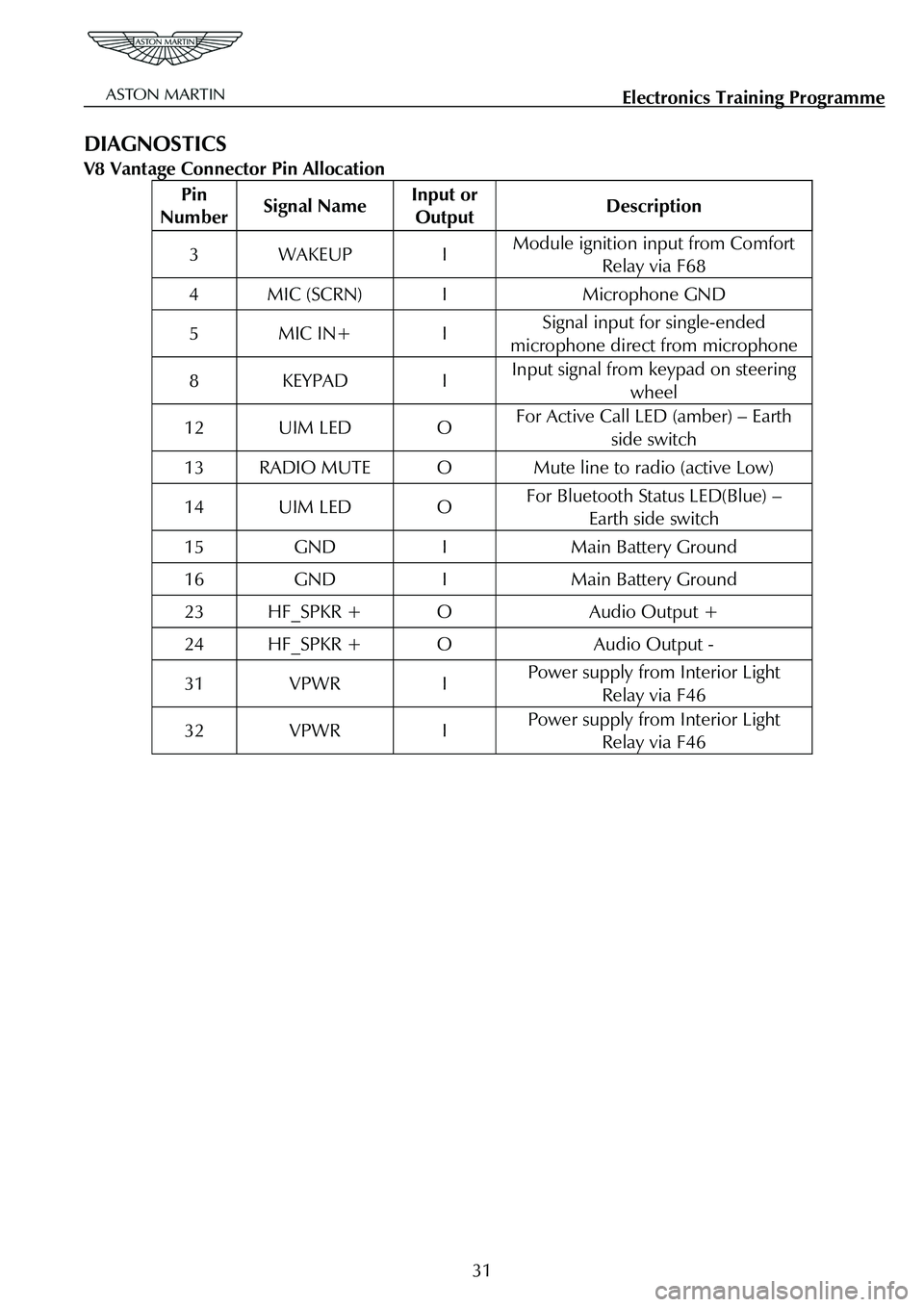
Electronics Training Programme
DIAGNOSTICS
V8 Vantage Connector Pin Allocation
Pin
Number Signal Name Input or
Output Description
3 WAKEUP I Module ignition input from Comfort
Relay via F68
4 MIC (SCRN) I Microphone GND
5 MIC IN+ I Signal input for single-ended
microphone direct from microphone
8 KEYPAD I Input signal from keypad on steering wheel
12 UIM LED O For Active Call LED (amber) – Earth
side switch
13 RADIO MUTE O Mute line to radio (active Low)
14 UIM LED O For Bluetooth Status LED(Blue) – Earth side switch
15 GND I Main Battery Ground
16 GND I Main Battery Ground
23 HF_SPKR + O Audio Output +
24 HF_SPKR + O Audio Output -
31 VPWR I Power supply from Interior Light Relay via F46
32 VPWR I Power supply from Interior Light Relay via F46
31
Page 837 of 947
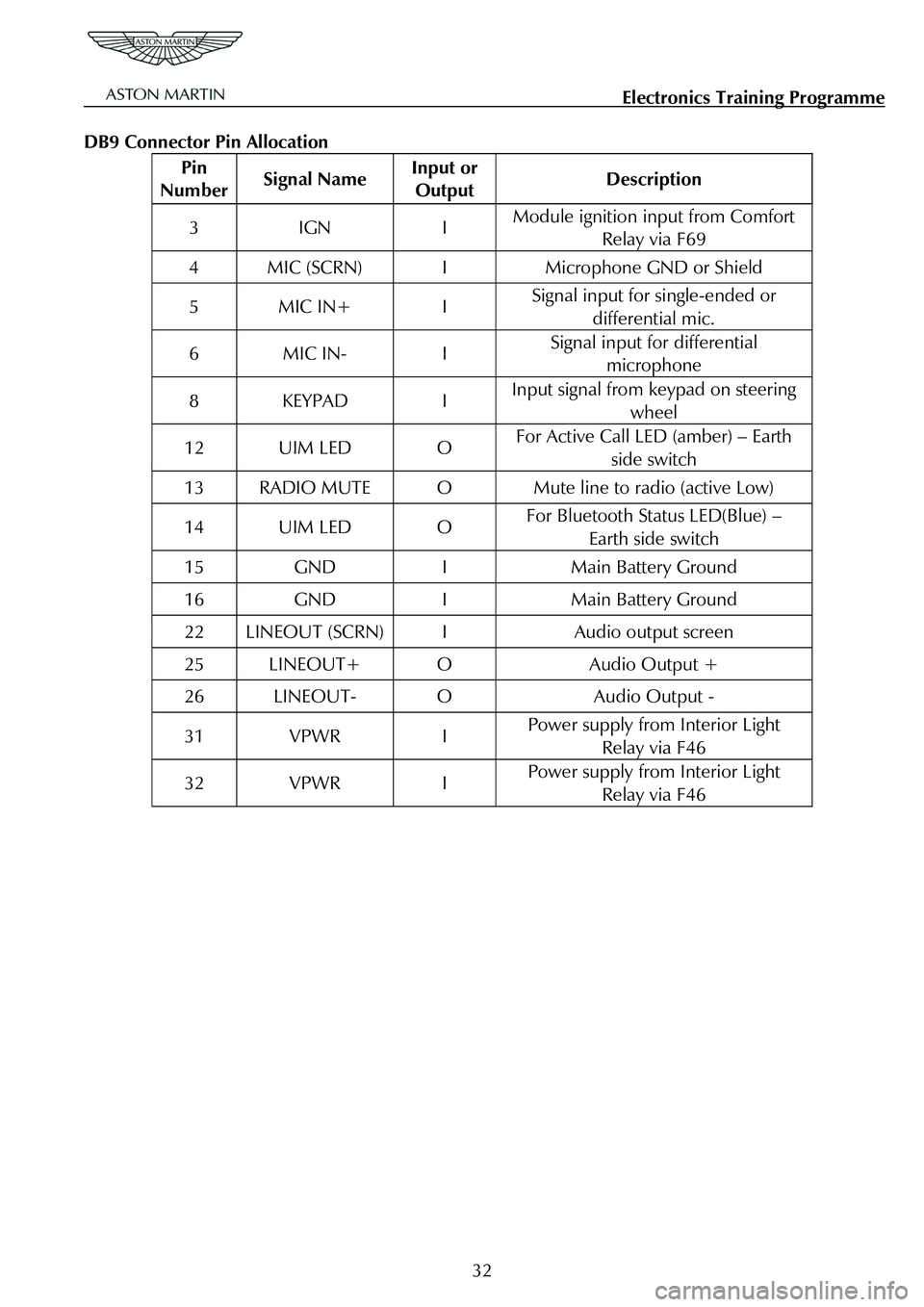
Electronics Training Programme
DB9 Connector Pin Allocation
Pin
Number Signal Name Input or
Output Description
3 IGN I Module ignition input from Comfort
Relay via F69
4 MIC (SCRN) I Microphone GND or Shield
5 MIC IN+ I Signal input for single-ended or
differential mic.
6 MIC IN- I Signal input for differential microphone
8 KEYPAD I Input signal from keypad on steering
wheel
12 UIM LED O For Active Call LED (amber) – Earth side switch
13 RADIO MUTE O Mute line to radio (active Low)
14 UIM LED O For Bluetooth Status LED(Blue) – Earth side switch
15 GND I Main Battery Ground
16 GND I Main Battery Ground
22 LINEOUT (SCRN) I Audio output screen
25 LINEOUT+ O Audio Output +
26 LINEOUT- O Audio Output -
31 VPWR I Power supply from Interior Light Relay via F46
32 VPWR I Power supply from Interior Light Relay via F46
32
Page 898 of 947
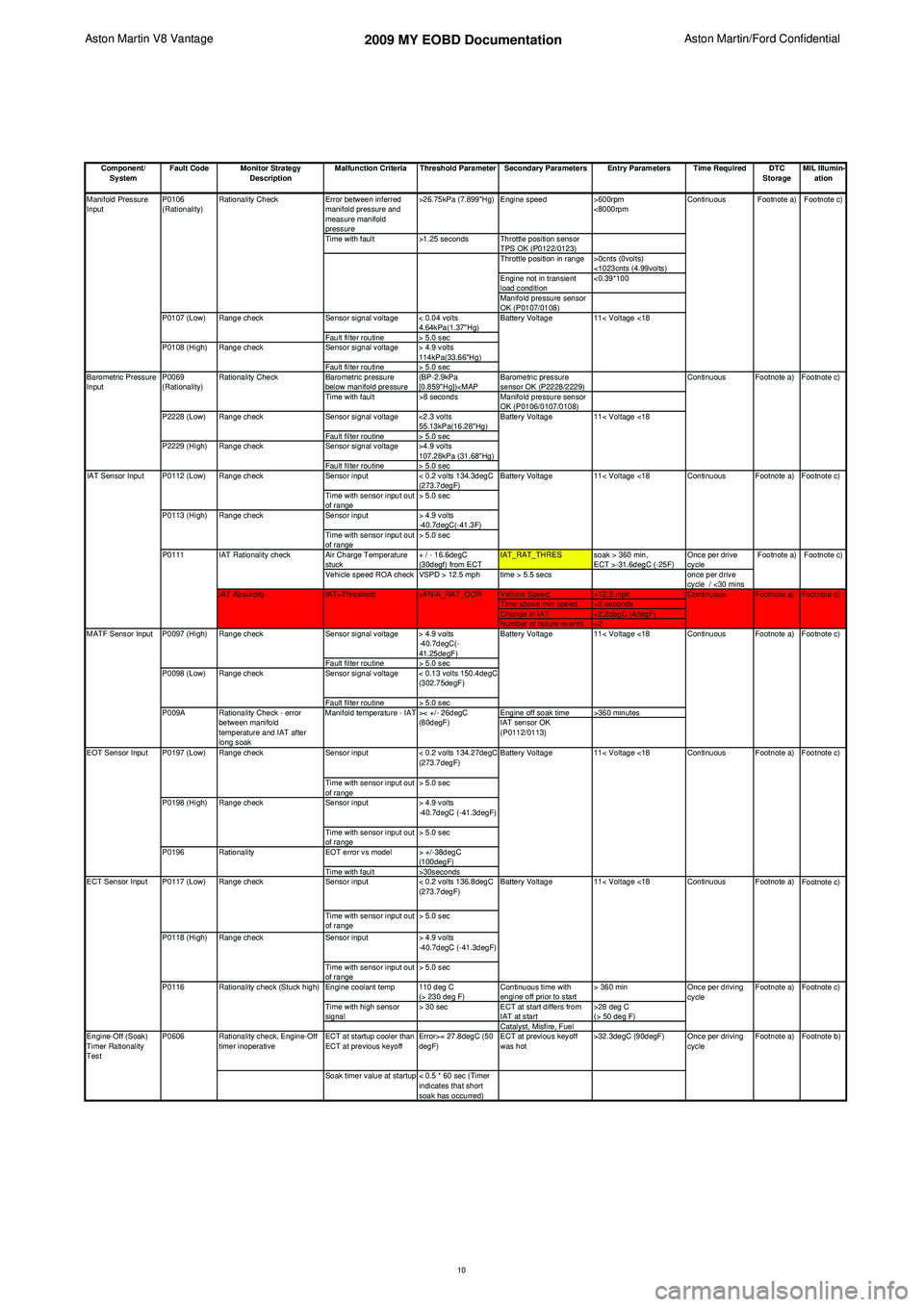
Aston Martin V8 Vantage 2009 MY EOBD DocumentationAston Martin/Ford Confidential
Component/ System Fault Code Monitor Strategy
Description Malfunction Criteria Threshold Parameter Secondary Parameters Entry Parameters Time Required DTC
StorageMIL Illumin-
ation
Error between inferred
manifold pressure and
measure manifold
pressure >26.75kPa (7.899"Hg) Engine speed
>600rpm
<8000rpm
Time with fault >1.25 seconds Throttle position sensor
TPS OK (P0122/0123)
Throttle position in range >0cnts (0volts) <1023cnts (4.99volts)
Engine not in transient
load condition <0.39*100
Manifold pressure sensor
OK (P0107/0108)
Sensor signal voltage < 0.04 volts 4.64kPa(1.37"Hg)
Fault filter routine > 5.0 sec
Sensor signal voltage > 4.9 volts 114kPa(33.66"Hg)
Fault filter routine > 5.0 sec
Barometric pressure
below manifold pressure (BP-2.9kPa
[0.859"Hg])
Time with fault >8 secondsManifold pressure sensor
OK (P0106/0107/0108)
Sensor signal voltage <2.3 volts 55.13kPa(16.28"Hg)
Fault filter routine > 5.0 sec
Sensor signal voltage >4.9 volts 107.28kPa (31.68"Hg)
Fault filter routine > 5.0 sec
Sensor input < 0.2 volts 134.3degC
(273.7degF)
Time with sensor input out
of range > 5.0 sec
Sensor input > 4.9 volts
-40.7degC(-41.3F)
Time with sensor input out
of range > 5.0 sec
Air Charge Temperature
stuck + / - 16.6degC
(30degf) from ECT IAT_RAT_THRES soak > 360 min,
ECT >-31.6degC (-25F)Once per drive
cycle
Vehicle speed ROA check VSPD > 12.5 mph time > 5.5 secs once per drive
cycle / <30 mins
Vehicle Speed >12.5 mph
Time above min speed >5 seconds
Change in IAT <2.2degC (4degF)
Number of failure events >2
Sensor signal voltage > 4.9 volts -40.7degC(-
41.25degF)
Fault filter routine > 5.0 sec
Sensor signal voltage < 0.13 volts 150.4degC (302.75degF)
Fault filter routine > 5.0 sec Engine off soak time >360 minutes
IAT sensor OK
(P0112/0113)
Sensor input < 0.2 volts 134.27degC
(273.7degF)
Time with sensor input out
of range > 5.0 sec
Sensor input > 4.9 volts
-40.7degC (-41.3degF)
Time with sensor input out
of range > 5.0 sec
EOT error vs model > +/-38degC (100degF)
Time with fault >30seconds
Sensor input < 0.2 volts 136.8degC
(273.7degF)
Time with sensor input out
of range > 5.0 sec
Sensor input > 4.9 volts
-40.7degC (-41.3degF)
Time with sensor input out
of range > 5.0 sec
Engine coolant temp 110 deg C (> 230 deg F)Continuous time with
engine off prior to start > 360 min
Time with high sensor
signal > 30 sec
ECT at start differs from
IAT at start >28 deg C
(> 50 deg F)
Catalyst, Misfire, Fuel
Rationality check, Engine-Off
timer inoperative ECT at startup cooler than
ECT at previous keyoffError>= 27.8degC (50
degF)ECT at previous keyoff
was hot >32.3degC (90degF)
Soak timer value at startup < 0.5 * 60 sec (Timer indicates that short
soak has occurred)
IAT Sensor Input
P0111IAT Absurdity >FNIA_RAT_OOR
IAT Rationality check
Footnote a) Footnote c)
IAT>Threshold
Footnote c)
Footnote c)
Footnote b)
Once per driving
cycle
Footnote a)
Footnote a)
Footnote a)
Footnote c)
Footnote a)
Footnote a)
>< +/- 26degC
(80degF)
Continuous
Battery Voltage
ECT Sensor Input
Engine-Off (Soak)
Timer Rationality
Test P0606
Once per driving
cycle
Range check
11< Voltage <18
Continuous
P0116 Rationality check (Stuck high) Battery Voltage
P0117 (Low)
P0118 (High) Range check 11< Voltage <18
Battery Voltage 11< Voltage <18 Continuous
P0197 (Low)
P0198 (High) Range check
Range check
EOT Sensor Input
P0196 Rationality
P0112 (Low)
P0113 (High)
Range check
Range check
MATF Sensor Input P009A Rationality Check - error between manifold
temperature and IAT after
long soak Footnote a) Footnote c)
P0106
(Rationality) Rationality Check
Manifold Pressure
Input
P0108 (High) Range check Continuous
Battery Voltage 11< Voltage <18
P0107 (Low) Range check
Barometric Pressure
Input P2228 (Low)
P2229 (High)Range check
Range check
P0069
(Rationality)
Rationality Check
Battery Voltage11< Voltage <18
Battery Voltage 11< Voltage <18 Footnote c)
Footnote a)
Continuous Footnote a) Footnote c)
Footnote c)Footnote c)
Footnote a)
Continuous
Continuous
Manifold temperature - IAT
P0097 (High)
P0098 (Low)
Range check
Range check
10
Page 903 of 947
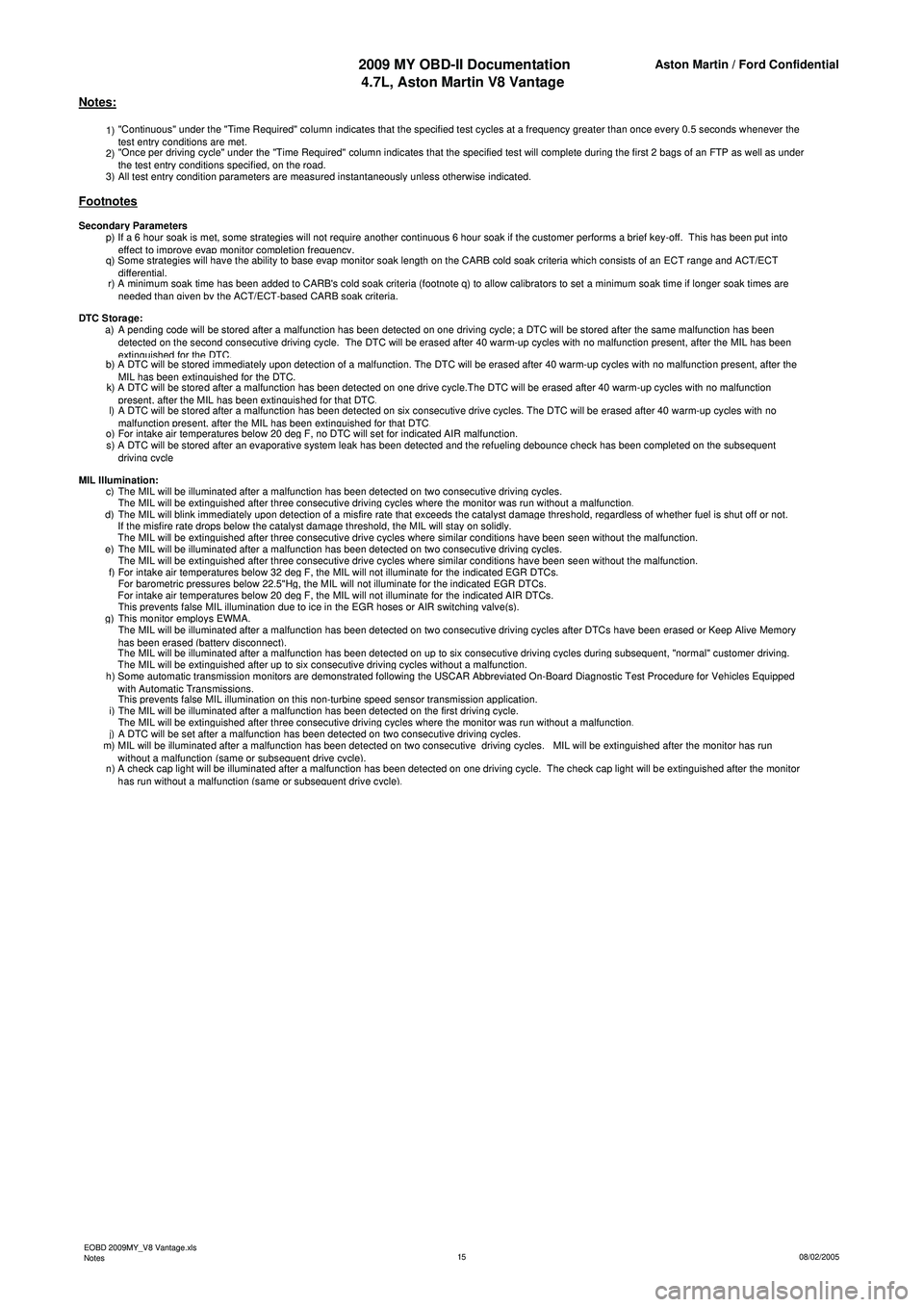
2009 MY OBD-II Documentation4.7L, Aston Martin V8 VantageAston Martin / Ford Confidential
1) "Continuous" under the "Time Required" column indicates that the specified test cycles at a frequency greater than once every 0.5 seconds whenever the
test entry conditions are met.
2) "Once per driving cycle" under the "Time Required" column indicates that the specified test will complete during the first 2 bags of an FTP as well as under
the test entr
y conditions specified, on the road.
3)All test entry condition parameters are measured instantaneously unless otherwise indicated.
p) If a 6 hour soak is met, some strategies will not require another continuous 6 hour soak if the customer performs a brief key-off. This has been put into
effect to improve evap monitor completion frequency.
q) Some strategies will have the ability to base evap monitor soak length on the CARB cold soak criteria which consists of an ECT range and ACT/ECT
differential.
r) A minimum soak time has been added to CARB's cold soak criteria (footnote q) to allow calibrators to set a minimum soak time if longer soak times are
n
eeded than given by the ACT/ECT-based CARB soak criteria.
a) A pending code will be stored after a malfunction has been detected on one driving cycle; a DTC will be stored after the same malfunction has been detected on the second consecutive driving cycle. The DTC will be erased after 40 warm-up cycles with no malfunction present, after the MIL has been
extinguished for the DTC.b) A DTC will be stored immediately upon detection of a malfunction. The DTC will be erased after 40 warm-up cycles with no malfunction present, after the MIL has been extinguished for the DTC.k) A DTC will be stored after a malfunction has been detected on one drive cycle.The DTC will be erased after 40 warm-up cycles with no malfunction present, after the MIL has been extinguished for that DTC.l) A DTC will be stored after a malfunction has been detected on six consecutive drive cycles. The DTC will be erased after 40 warm-up cycles with no malfunction present, after the MIL has been extinguished for that DTC.o)For intake air temperatures below 20 deg F, no DTC will set for indicated AIR malfunction.
s) A DTC will be stored after an evaporative system leak has been detected and the refueling debounce check has been completed on the subsequent
driving cycle
c)The MIL will be illuminated after a malfunction has been detected on two consecutive driving cycles.
The MIL will be extinguished after three consecutive driving cycles where the monitor was run without a malfunction.d)The MIL will blink immediately upon detection of a misfire rate that exceeds the catalyst damage threshold, regardless of whether fuel is shut off or not.
If the misfire rate drops below the catalyst damage threshold, the MIL will stay on solidly.
The MIL will be extinguished after three consecutive drive cycles where similar conditions have been seen without the malfunction.e)The MIL will be illuminated after a malfunction has been detected on two consecutive driving cycles.
The MIL will be extinguished after three consecutive drive cycles where similar conditions have been seen without the malfunction.f)For intake air temperatures below 32 deg F, the MIL will not illuminate for the indicated EGR DTCs.
For barometric pressures below 22.5"Hg, the MIL will not illuminate for the indicated EGR DTCs.
For intake air temperatures below 20 deg F, the MIL will not illuminate for the indicated AIR DTCs.
This prevents false MIL illumination due to ice in the EGR hoses or AIR switching valve(s).g)This monitor employs EWMA.
The MIL will be illuminated after a malfunction has been detected on two consecutive driving cycles after DTCs have been erased or Keep Alive Memory
h
as been erased (battery disconnect).
The MIL will be illuminated after a malfunction has been detected on up to six consecutive driving cycles during subsequent, "normal" customer driving.
The MIL will be extinguished after up to six consecutive driving cycles without a malfunction.
h) Some automatic transmission monitors are demonstrated following the USCAR Abbreviated On-Board Diagnostic Test Procedure for Vehicles Equipped
wi
th Automatic Transmissions.
This prevents false MIL illumination on this non-turbine speed sensor transmission application.
i)The MIL will be illuminated after a malfunction has been detected on the first driving cycle.
The MIL will be extinguished after three consecutive driving cycles where the monitor was run without a malfunction.j)A DTC will be set after a malfunction has been detected on two consecutive driving cycles.
m) MIL will be illuminated after a malfunction has been detected on two consecutive driving cycles. MIL will be extinguished after the monitor has run
wi
thout a malfunction (same or subsequent drive cycle).
n) A check cap light will be illuminated after a malfunction has been detected on one driving cycle. The check cap light will be extinguished after the monitor
h
as run without a malfunction (same or subsequent drive cycle).
MIL Illumination:
Notes:
Footnotes
Secondary Parameters
DTC Stora
ge:
EOBD 2009MY_V8 Vantage.xls
Notes 08/02/2005
15
Page 905 of 947
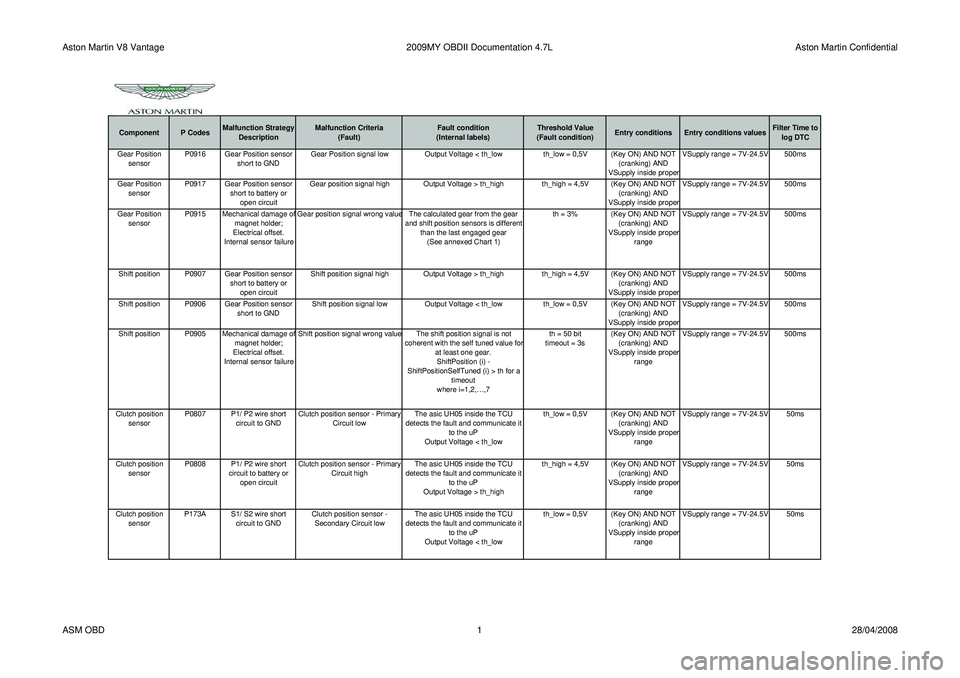
Aston Martin V8 Vantage2009MY OBDII Documentation 4.7L Aston Martin Confidential
Component P CodesMalfunction Strategy
Description Malfunction Criteria
(Fault) Fault condition
(Internal labels) Threshold Value
(Fault condition) Entry conditions Entry conditions values Filter Time to
log DTC
Gear Position sensor P0916 Gear Position sensor
short to GND Gear Position signal low Output Voltage < th_low th_low = 0,5V (Key ON) AND NOT
(cranking) AND
VSupply inside prope
r VSupply range = 7V-24.5V 500ms
Gear Position sensor P0917 Gear Position sensor
short to battery or open circuit Gear position signal high Output Voltage > th_high
th_high = 4,5V (Key ON) AND NOT
(cranking) AND
VSupply inside proper VSupply range = 7V-24.5V 500ms
Gear Position sensor P0915 Mechanical damage o
f
magnet holder;
Electrical offset.
Internal sensor failure Gear position signal wrong value The calculated gear from the gear
and shift position sensors is different than the last engaged gear(See annexed Chart 1) th = 3% (Key ON) AND NOT
(cranking) AND
VSupply inside prope
r
range VSupply range = 7V-24.5V 500ms
Shift position P0907 Gear Position sensor short to battery or open circuit Shift position signal high Output Voltage > th_high
th_high = 4,5V (Key ON) AND NOT
(cranking) AND
VSupply inside proper VSupply range = 7V-24.5V 500ms
Shift position P0906 Gear Position sensor short to GNDShift position signal low
Output Voltage < th_low th_low = 0,5V (Key ON) AND NOT
(cranking) AND
VSupply inside proper VSupply range = 7V-24.5V 500ms
Shift position P0905 Mechanical damage o
f
magnet holder;
Electrical offset.
Internal sensor failure Shift position signal wrong value The shift position signal is not
coherent with the self tuned value fo
r
at least one gear.ShiftPosition (i) -
ShiftPositionSelfTuned (i) > th for a timeout
where i=1,2,…,7 th = 50 bit
timeout = 3s (Key ON) AND NOT
(cranking) AND
VSupply inside prope
r
range VSupply range = 7V-24.5V 500ms
Clutch position sensor P0807 P1/ P2 wire short
circuit to GND Clutch position sensor - Primary
Circuit low The asic UH05 inside the TCU
detects the fault and communicate it to the uP
Output Voltage < th_low th_low = 0,5V (Key ON) AND NOT
(cranking) AND
VSupply inside proper
range VSupply range = 7V-24.5V 50ms
Clutch position sensor P0808 P1/ P2 wire short
circuit to battery or open circuit Clutch position sensor - Primary
Circuit high The asic UH05 inside the TCU
detects the fault and communicate it to the uP
Output Voltage > th_high th_high = 4,5V (Key ON) AND NOT
(cranking) AND
VSupply inside proper
range VSupply range = 7V-24.5V 50ms
Clutch position sensor P173A S1/ S2 wire short
circuit to GND Clutch position sensor -
Secondary Circuit low The asic UH05 inside the TCU
detects the fault and communicate it to the uP
Output Voltage < th_low th_low = 0,5V (Key ON) AND NOT
(cranking) AND
VSupply inside proper
range VSupply range = 7V-24.5V 50ms
ASM OBD
128/04/2008
Page 906 of 947
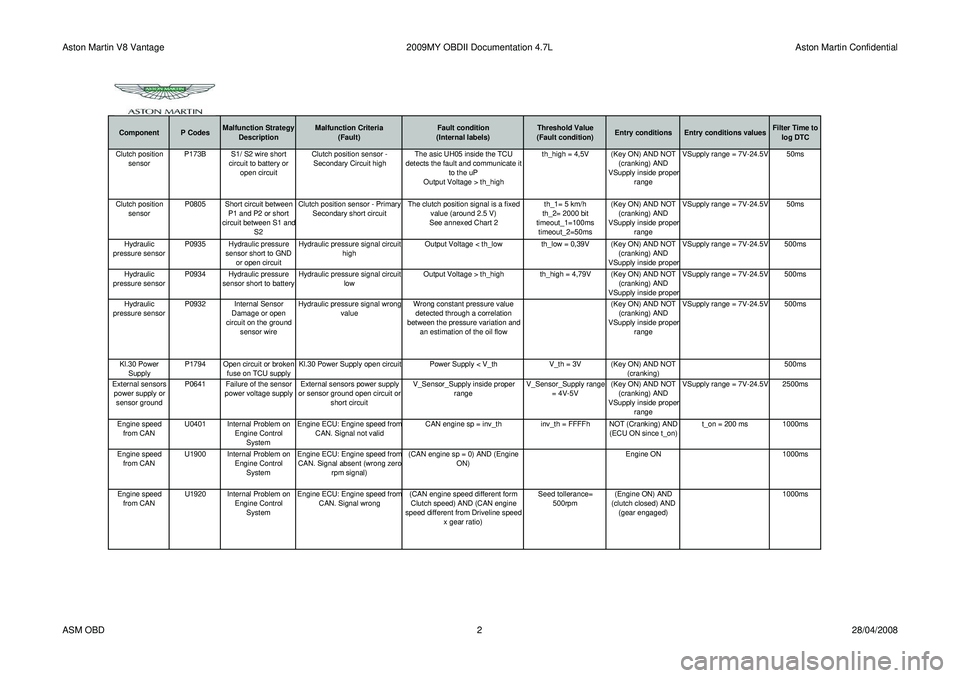
Aston Martin V8 Vantage2009MY OBDII Documentation 4.7L Aston Martin Confidential
Component P CodesMalfunction Strategy
Description Malfunction Criteria
(Fault) Fault condition
(Internal labels) Threshold Value
(Fault condition) Entry conditions Entry conditions values Filter Time to
log DTCClutch position sensor P173B S1/ S2 wire short
circuit to battery or open circuit Clutch position sensor -
Secondary Circuit high The asic UH05 inside the TCU
detects the fault and communicate it to the uP
Output Voltage > th_high th_high = 4,5V (Key ON) AND NOT
(cranking) AND
VSupply inside prope
r
range VSupply range = 7V-24.5V 50ms
Clutch position sensor P0805 Short circuit between
P1 and P2 or short
circuit between S1 and S2 Clutch position sensor - Primary
Secondary short circuit The clutch position signal is a fixed
value (around 2.5 V)
See annexed Chart 2 th_1= 5 km/h
th_2= 2000 bit
timeout_1=100ms timeout_2=50ms (Key ON) AND NOT
(cranking) AND
VSupply inside proper
range VSupply range = 7V-24.5V 50ms
Hydraulic
pressure sensor P0935 Hydraulic pressure
sensor short to GND or open circuit Hydraulic pressure signal circuit
high Output Voltage < th_low th_low = 0,39V (Key ON) AND NOT
(cranking) AND
VSupply inside proper VSupply range = 7V-24.5V 500ms
Hydraulic
pressure sensor P0934 Hydraulic pressure
sensor short to battery Hydraulic pressure signal circuit
low Output Voltage > th_high th_high = 4,79V (Key ON) AND NOT
(cranking) AND
VSupply inside proper VSupply range = 7V-24.5V 500ms
Hydraulic
pressure sensor P0932 Internal Sensor
Damage or open
circuit on the ground sensor wire Hydraulic pressure signal wrong
value Wrong constant pressure value
detected through a correlation
between the pressure variation and an estimation of the oil flow (Key ON) AND NOT
(cranking) AND
VSupply inside proper
range VSupply range = 7V-24.5V 500ms
Kl.30 Power Supply P1794 Open circuit or broken
fuse on TCU supply Kl.30 Power Supply open circuit Power Supply < V_th
V_th = 3V (Key ON) AND NOT
(cranking) 500ms
External sensors power supply or sensor ground P0641 Failure of the sensor
power voltage supply External sensors power supply
or sensor ground open circuit or short circuit V_Sensor_Supply inside proper
range V_Sensor_Supply range
= 4V-5V (Key ON) AND NOT
(cranking) AND
VSupply inside proper
range VSupply range = 7V-24.5V 2500ms
Engine speed from CAN U0401 Internal Problem on
Engine Control System Engine ECU: Engine speed fro
m
CAN. Signal not valid
CAN engine sp = inv_th inv_th = FFFFh NOT (Cranking) AND
(ECU ON since t_on)t_on = 200 ms 1000ms
Engine speed from CAN U1900 Internal Problem on
Engine Control System Engine ECU: Engine speed fro
m
CAN. Signal absent (wrong zero
rpm signal) (CAN engine sp = 0) AND (Engine
ON) Engine ON 1000ms
Engine speed from CAN U1920 Internal Problem on
Engine Control System Engine ECU: Engine speed fro
m
CAN. Signal wrong
(CAN engine speed different form
Clutch speed) AND (CAN engine
speed different from Driveline speed x gear ratio) Seed tollerance=
500rpm (Engine ON) AND
(clutch closed) AND (gear engaged) 1000ms
ASM OBD
228/04/2008
Page 907 of 947
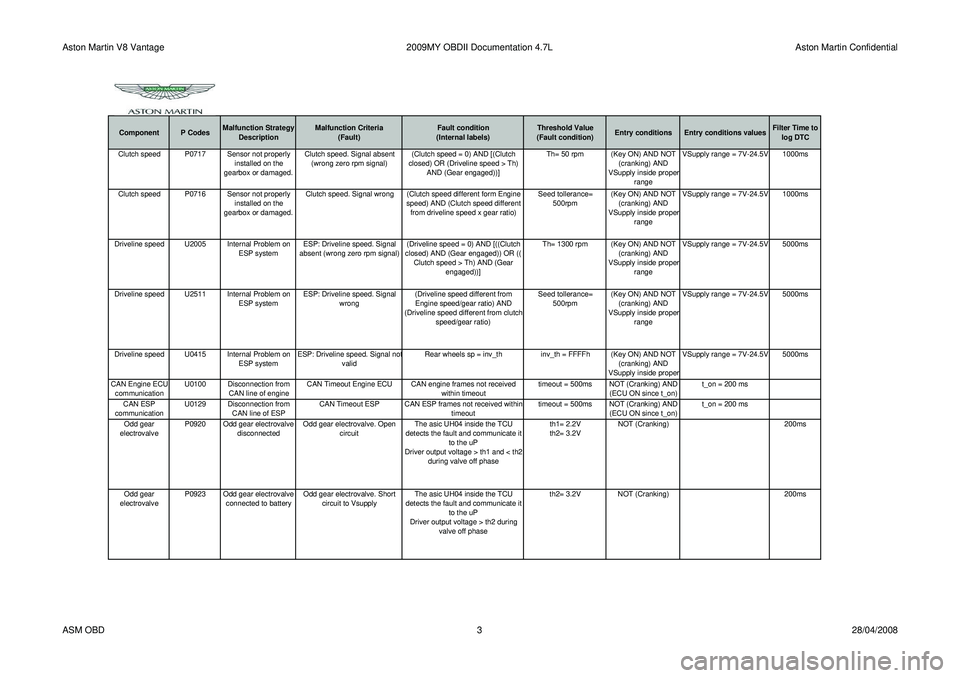
Aston Martin V8 Vantage2009MY OBDII Documentation 4.7L Aston Martin Confidential
Component P CodesMalfunction Strategy
Description Malfunction Criteria
(Fault) Fault condition
(Internal labels) Threshold Value
(Fault condition) Entry conditions Entry conditions values Filter Time to
log DTCClutch speed P0717 Sensor not properly installed on the
gearbox or damaged. Clutch speed. Signal absent
(wrong zero rpm signal) (Clutch speed = 0) AND [(Clutch
closed) OR (Driveline speed > Th) AND (Gear engaged))] Th= 50 rpm (Key ON) AND NOT
(cranking) AND
VSupply inside prope
r
range VSupply range = 7V-24.5V 1000ms
Clutch speed P0716 Sensor not properly installed on the
gearbox or damaged. Clutch speed. Signal wrong (Clutch speed different form Engine
speed) AND (Clutch speed different from driveline speed x gear ratio) Seed tollerance=
500rpm (Key ON) AND NOT
(cranking) AND
VSupply inside proper
range VSupply range = 7V-24.5V 1000ms
Driveline speed U2005 Internal Problem on ESP systemESP: Driveline speed. Signal
absent (wrong zero rpm signal) (Driveline speed = 0) AND [((Clutch
closed) AND (Gear engaged)) OR (( Clutch speed > Th) AND (Gear engaged))] Th= 1300 rpm (Key ON) AND NOT
(cranking) AND
VSupply inside proper
range VSupply range = 7V-24.5V 5000ms
Driveline speed U2511 Internal Problem on ESP systemESP: Driveline speed. Signal
wrong (Driveline speed different from
Engine speed/gear ratio) AND
(Driveline speed different from clutch speed/gear ratio) Seed tollerance=
500rpm (Key ON) AND NOT
(cranking) AND
VSupply inside proper
range VSupply range = 7V-24.5V 5000ms
Driveline speed U0415 Internal Problem on ESP systemESP: Driveline speed. Signal no
t
valid Rear wheels sp = inv_th
inv_th = FFFFh (Key ON) AND NOT
(cranking) AND
VSupply inside prope
r VSupply range = 7V-24.5V 5000ms
CAN Engine ECU communication U0100 Disconnection from
CAN line of engine CAN Timeout Engine ECU CAN engine frames not received
within timeouttimeout = 500ms NOT (Cranking) AND
(ECU ON since t_on) t_on = 200 ms
CAN ESP
communication U0129 Disconnection from
CAN line of ESP CAN Timeout ESP CAN ESP frames not received within
timeouttimeout = 500ms NOT (Cranking) AND
(ECU ON since t_on) t_on = 200 ms
Odd gear
electrovalve P0920 Odd gear electrovalve
disconnected Odd gear electrovalve. Open
circuit The asic UH04 inside the TCU
detects the fault and communicate it to the uP
Driver output voltage > th1 and < th2 during valve off phase th1= 2.2V
th2= 3.2V
NOT (Cranking)
200ms
Odd gear
electrovalve P0923 Odd gear electrovalve
connected to battery Odd gear electrovalve. Short
circuit to Vsupply The asic UH04 inside the TCU
detects the fault and communicate it to the uP
Driver output voltage > th2 during valve off phase th2= 3.2V
NOT (Cranking) 200ms
ASM OBD 328/04/2008